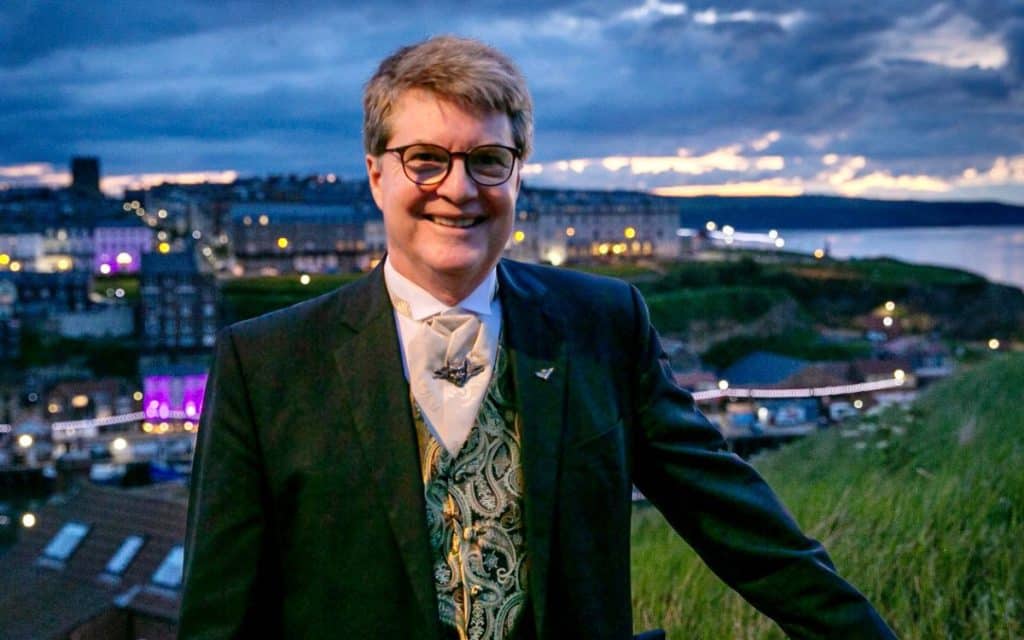Dacre Stoker went from unaware descendant to devoted guardian of Bram Stoker’s legacy. He tells DAVID SAUNDERSON about uncovering his past and keeping Dracula’s story alive.
For many families, a famous ancestor becomes the stuff of myth. For Dacre Stoker, growing up in Canada during the 1960s and 70s, Bram Stoker’s name was barely mentioned at all.
The man who gave the world Dracula was his great-grand-uncle, yet within the Stoker family, the connection was little more than a whisper.
“No, it’s not a big thing,” Dacre explained. “You’ve got to put things in context. First of all, we’re Canadians, so we don’t really thump our chest and say, oh, look what we’ve done.
“But it was also the timeframe. I was born in 1958. I started understanding this stuff in the mid-60s, early 70s. So there really wasn’t much the family knew. We weren’t a source of information about Bram Stoker. I had to get it from McNally and Florescu, Barbara Belford, David Skal… Daniel Farson, who was actually a distant relative.”
Halloween jokes and strange looks
To the young Dacre, vampires were just figures from television shows and cartoons. At Halloween, trick-or-treaters would laugh: “The Stokers—are you going to give us sweets, or take our blood?” He didn’t get the joke.
“It was sort of these Halloween times,” Dacre remembered. “People would come to the door—‘Ooh, the Stoker family, are you going to give us sweets or take our blood?’ Finally I asked my dad, I think at the age of 13 or 14, what is going on?”
That was the first time anyone in the family explained it to him.
Bram Stoker, the man behind Dracula, was his relative. To prove it, his father showed him a family treasure: a copy of Dracula signed by Bram himself to his mother, just eight days before the novel’s publication in 1897.
For Dacre, it was a revelation. Until that moment, he hadn’t truly understood who Bram Stoker was—or what he meant to him.

Unlocking the family trunks
For years afterwards, the discovery of Bram’s place in the family was little more than trivia. Dacre became an Olympic-level athlete and later taught science and physical education.
But in 2005, everything changed.
“Well, nobody else was really doing it in the family,” he said. “And it was sort of in that 2005 period when I stopped teaching at a school in South Carolina. I said, okay, I’ve got to take a break from this.
“I’ve been teaching for 25 years, physical education and science, and it’s now time to do something different. And it sort of fell into my lap… my uncle in Canada said, ‘Hey, I’ve got some information you might be interested in.’
“My wife and I were the only genealogists in the family, really. And so he started sending me stuff and then he said, ‘I’ve been diagnosed with congenital heart failure. Nobody else in the family really cares as much as you and Jenny do. Would you come up to Montreal?’
“We flew up… and we opened up all these trunks and went through, it took us about a full day and a half to go through all these letters from people like Hall Caine, Ellen Terry.
“It was like, my God, there’s a treasure trove here. And nobody is—this stuff’s gonna die or rot in these trunks. So I better do something.”
From guardian to researcher
What began as scanning old letters soon turned into a worldwide quest.
Dacre travelled to the Rosenbach Museum in Philadelphia to study Bram’s source notes. He flew to Seattle to examine the Dracula typescript owned by Paul Allen.
In Dublin and London, he traced Bram’s footsteps through archives and libraries, finding proof of the meticulous research that fed Dracula.
Scholars who had studied Bram for decades quickly saw the value of what Dacre was uncovering. When he shared the discovery of Bram’s lost Dublin journal with Dr Elizabeth Miller, she was ecstatic.
“She just about did backflips,” Dacre laughed. “It opened up a stage of Bram’s life that nobody knew about… that was something that many scholars were dying for. And I think I satisfied their thirst because it opened up.”
These discoveries soon pushed Dacre from archivist into author.
With Ian Holt, he co-wrote Dracula the Un-Dead (2009). With J.D. Barker, he crafted Dracul (2018), blending family lore and fiction.
He published Bram Stoker’s Lost Journal (2012), and co-edited Dracula Annotated for the 125th Anniversary (2022), restoring deleted chapters and an explosive alternate ending.
Carrying Bram Stoker’s flame forward
Today, Dacre is known around the world as the family voice of Bram Stoker.
He has appeared in documentaries, led tours to Whitby, Dublin, Cruden Bay, and Transylvania, and spoken at countless conventions and universities.
For him, the mission is clear.
“What keeps me going is the enthusiasm,” Dacre said. “Not just mine, but from the people who want to see where it all began—what inspired Bram, what motivated him.
“And for me, it’s about telling the truth about Bram, connecting the dots, and making sure his real story isn’t lost.”
What did you think of this article about Bram Stoker’s enduring legacy? Let us know in the comments below!
Dacre Stoker is leading a trip to Romania this Halloween 2025. On our recent podcast, Dacre speaks to Spooky Isles about the adventure, as well as other thoughts on Dracula and his great-granduncle’s legacy.
- Book your Dracula adventure with Dacre Stoker: Mysterious Adventures Tours
- Listen to the full interview here: Spooky Isles Podcast with Dacre Stoker


